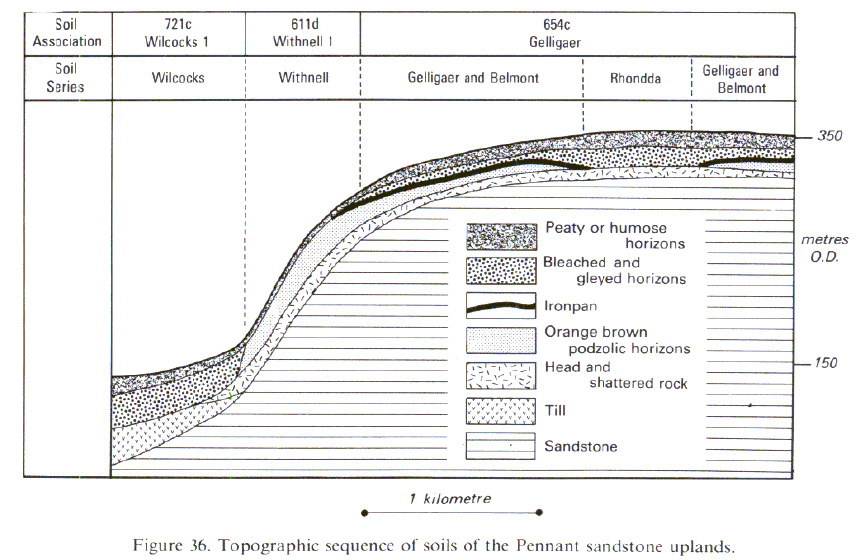
Soil Associations
0654c Gelligaer
Soil and site characteristics
Loamy permeable upland soils over sandstone with a wet peaty surface horizon and bleached subsurface horizon. Some soils with thin ironpan. Rock and scree locally.
Geology
Palaeozoic sandstone
Cropping and Land Use
Wet moorland habitats of poor and moderate grassing value; recreation; coniferous woodland.
Component soil series
| Subgroup | Series name | Percentage | WRB 2006 link |
|---|---|---|---|
| 6.54 | GELLIGAER | 35% | Endoleptic Histic Stagnic Albic Podzols |
| 6.51 | BELMONT | 25% | Placic Endoleptic Histic Stagnic Albic Podzols |
| 7.21 | RHONDDA | 25% | Dystric Histic Stagnosols |
Covers 283 km2 in England and Wales
Soilscapes Classification
| 16 |
Very acid loamy upland soils with a wet peaty surface |
0654c Gelligaer
Detailed Description
Coarse loamy ferric stagnopodzols (Gelligaer series) and ironpan stagnopodzols (Belmont series) are predominant above 350 m O.D. on the summit plateaux and ridges of the Pennant sandstone uplands in the south Wales coalfield. The soils are extremely acid with a peaty top about 20 cm thick but thinner on steep slopes. They have a grey, strongly leached, often very stony subsurface horizon with evidence of gleying underlain by a thin dark reddish zone of iron, aluminium and humus accumulation. In the Belmont series this takes the form of a thin ironpan no more than a few millimetres thick. Such ironpans are rarely continuous and in sections along forest roads can be seen to disappear and reappear within a few metres. Weaker ironpans occur in the Gelligaer series in the form of egg-cup shaped coatings on prismatic peds in the subsurface gleyed horizon. The subsoils of Gelligaer and Belmont series are freely draining and brightly coloured like those of Withnell series on adjacent slopes. This, with archaeological evidence, suggests that stagnopodzols result from superficial modification of brown podzolic soils since Neolithic times. Most of the soils overlie sandstone Head or bedrock between 40 cm and 80 cm depth, but some are shallower, in which case an ironpan may be developed in rock debris. The Rhondda series (stagnohumic gley soils) is also common. These soils resemble stagnopodzols in having a peaty top over a gleyed horizon depleted of iron, but the underlying horizons are also gleyed with ochreous mottles, and they merge into rock debris at 50 to 80 cm depth. The Gelligaer series is most common overall but the proportions of Belmont and Rhondda series vary and either can be locally dominant. Gelligaer and Belmont soils are mainly found on convex, shedding sites while Rhondda soils generally lie on near-level or slightly concave slopes. The soil pattern is frequently complex, however, and soils with patchy ironpan development or gley mottling in the orange subsoil horizon are common. The association also includes patches of the Wilcocks series in impermeable drift and there is some peat usually in boggy depressions. On some narrow ridge tops there are typical podzols (Anglezarke series), which are drier than stagnopodzols and have a thin peaty top over a bleached horizon and a black humus pan about 3 cm thick, passing to a brightly coloured podzolic horizon and rock debris.
Soil Water Regime
Where undrained, the soils are wet for most of the year (Wetness Class V) with rapid winter run-off. Soil wetness results from a combination of high rainfall, low evapotranspiration and gentle relief, and the sponge-like properties of their peaty tops although many of the subsoils are relatively permeable. Thus they differ in their water regime from Wilcocks series on adjacent lower ground, which has slowly permeable subsoils.
Cropping and Land Use
The climate is wet, cold and very exposed so most of the land is under poor to moderate value rough grazing or forest. Bilberry heath and heather moor survive in places but mat-grass and purple moor-grass have become widespread after burning and grazing. The proportion of purple moor-grass varies considerably, often being abundant on the wetter Rhondda and Belmont series where the ironpan is well developed but only occasional on drier soils with thin surface peat. There has been little grassland improvement except on the margins of the association where Gelligaer soils are transformed by cultivation to typical or humic brown podzolic soils within a few years. The grassland would respond to the techniques of surface treatment developed at Pwllpeiran Experimental Husbandry Farm in mid-Wales on similar soils over shales (Hafren association). This involves flail mowing and burning to eliminate the mat of dead vegetation, followed by surface rotavation and reseeding, with large applications of lime, slag and nitrogen. There is, however, a great risk of poaching because of the wet climate and the water-holding properties of the peat. To prepare sites for forestry, the soils are ploughed deeply to break any ironpan and mix the peat and upper mineral horizons. This improves aeration and encourages deep rooting while improving run-off along the furrows into deep drains. Sitka spruce is commonly planted as it withstands exposure and yields moderately well, although, on ground covered by heather, early growth is commonly checked and herbicide is needed to permit crop establishment. Alternatively Lodgepole pine can be planted because it tolerates competition from ericaceous species much better.
0654c Gelligaer
Distribution Map
 |
Note that the yellow shading represents a buffer to highlight the location of very small areas of the association.
Keys to component soil series
Wales
 |
Typical Landscapes
Wales
 |
All information Copyright, Cranfield University © 2025
Citation: To use information from this web resource in your work, please cite this as follows:
Cranfield University 2025. The Soils Guide. Available: www.landis.org.uk. Cranfield University, UK. Last accessed 25/04/2025
